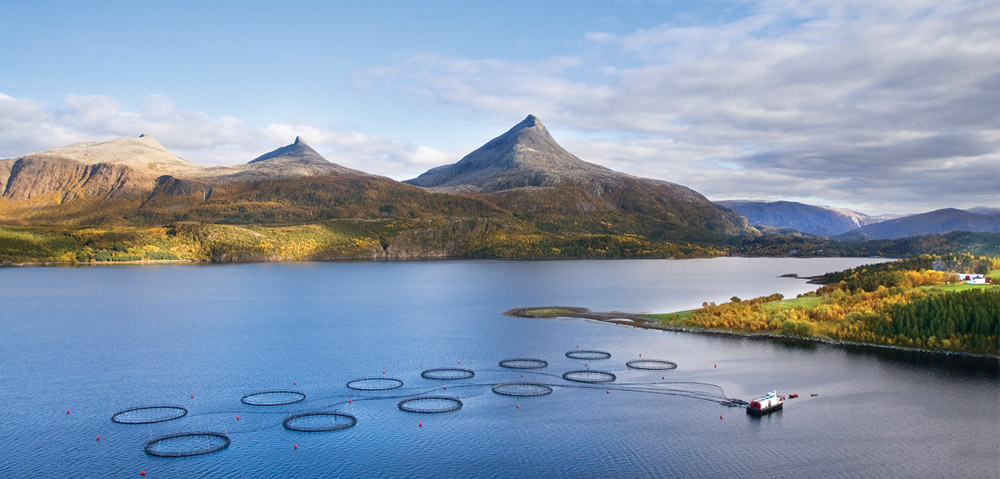
Sinkaberg-Hansen
Swimming up stream
Sinkaberg-Hansen has invested considerably over the years to meet growing global demand
Located in Outer Namdal, Bindal and headquartered in Marøy, Sinkaberg-Hansen employs a total of 195 employees spread across its various business areas including its fish farms, slaughterhouse, processing plant and subsidiary business Bindal Smolt AS. These members of staff are what the company itself deem to be its most important resource. As a demonstration to its commitment to human resources, the company was one of the first in the North Trøndelag region to introduce a 30-hour working week, broken up into six-hour shifts and allocated by a rota system. The reason for this decision was the company’s understanding that reduced hours in turn result in fewer strain injuries, increased job satisfaction and, ultimately, improved profits and results.
The fishing industry rose to prominence in the 1970s when people from all over the region began farming for salmon and trout by using cages. It was in 1977 that Finn Sinkaberg first put his own tanks and nets into the sea off the coast of Marøy. With sturdy, well manufactured equipment and good sea conditions Sinkaberg managed to harvest some 3000 fish in only his third year. In these early days the fish that were caught were collected in tanks and transported for slaughter at Fossa wharf, a process that continued until 1982, when the company built a modern facility in Marøy itself. It wasn’t until 1998 that the slaughterhouse that the company uses today was constructed. Today Sinkaberg-Hansen ensures the continuous improvement and upgrading of all of its technical equipment and facilities.
Situated close to the Bindal municipality, Sinkaberg-Hansen’s state-of-the-art hatchery produces around 2.5 million smolts annually, which are delivered between the months of April and October. The hatchery is where the first part of the fish’s life cycle occurs, an indoor facility where the fish eggs are stored in tanks after fertilization until they hatch. When the young salmon fry reach a certain size they are vaccinated against common diseases and one year down the line, when each individual fish weights roughly 100 grams, the salmon are ready to be moved into salt water and subsequently released into sea cages.
Modern farming methods are so advanced that often more than a million individual fish can be found divided around the site of a production facility. To prevent these farming areas from becoming contaminated with waste material pollutions they are often located in areas boasting good water flows and high depths. The fish are fed a diet of pellets made with marine and vegetable oils as well as proteins enriched with vitamins and minerals. Salmon feed also contains added astaxanthin, a natural product found in shrimp shells that gives the salmon its famous red colour. The feeding process is carried out by feed barges and regulated by an automated computer system that has all but eliminated food waste.
While most of the fish that is produced in Norway is gutted, placed on ice in boxes and then transported by car to the continent, where it is then processed, Sinkaberg-Hansen processes approximately 40 per cent of its own, self-produced fish, a trait that it believes contributes to its excellent product quality. When they are between two and three years old the salmon are taken to be slaughtered in the company’s modern slaughterhouse. This facility, with its high levels of automation, is capable of handling 120 tonnes of fish per day.
By controlling all of the raw materials that go into the slaughtering process Sinkaberg-Hansen can plan the production, harvesting, extraction and processing, without having to factor in market cost prices at any point. This means the company can achieve steady production levels throughout the year and provide a stable working environment for the facilities’ 33 employees. In 2006 the company built all new cold storage facilities to handle its increasing business levels and it still retains sufficient space and capacity to increase further in the event that salmon demand continues to grow.
In 2008 the company introduced its own staff veterinarian as a way of expanding its overall knowledge of its product and the biological environment it operates in. Sinkaberg-Hansen is fully aware of the importance of understanding the biological work that goes into the production of smolts and the harvesting and processing of adult fish. It is for this very reason that it today employs three experts in this field, two of which are specifically tasked with monitoring and following up on the slaughter and fabrication processes.
The company is equally aware of the need to maintain exceptional standards in food quality and its need to have as little impact on the surrounding environment as possible. In the context of ensuring food safety and quality, the company has introduced a strict regime of internal self-monitoring and is further audited annually by international public authorities. When it comes to the environment, not only does Sinkaberg-Hansen carry out countless studies on how to reduce its own impact through the reduction of emissions, it also co-operates with the other major names in the fish farming sector to collectively reduce the risk of outbreaks of contagious diseases amongst the local fish population.
In 2010 the company achieved an annual turnover of approximately 107 million euros. This strong result can be attributed to its smolt production figures of 2.5 million, 18,000 tonnes of self-produced salmon, its harvesting of 25,000 tonnes of salmon and the processing of some 8000 tonnes of fish fillets. While these figures are exceptional in their own right, Sinkaberg-Hansen will be aiming for 2011 to end up being an even more successful period for the business, a target that could soon be realised with its planned expansion of new premises opposite its existing production facility.